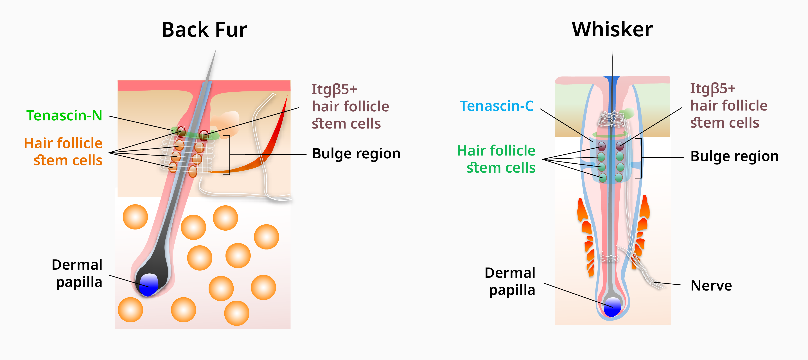Feb. 10, 2021 Press Release Biology Medicine / Disease
A recipe for cyclical regeneration of bioengineered hair
Next stop: clinical hair regeneration
Researchers at the RIKEN Center for Biosystems Dynamics Research in Japan have discovered a recipe for continuous cyclical regeneration of cultured hair follicles from hair follicle stem cells.
Scientists have been making waves in recent years by developing ways to grow a variety of useful items in laboratories, from meat and diamonds to retinas and other organoids. At the RIKEN Center for Biosystems Dynamics Research in Japan, a team led by Takashi Tsuji has been working on ways to regenerate lost hair from stem cells. In an important step, a new study identifies a critical population of hair follicle stem cells in the skin and a recipe for normal cyclical hair regeneration in the lab.
The researchers took fur and whisker cells from mice and cultured them in the laboratory with other biological “ingredients”. They used 220 combinations of ingredients, and found that combining a type of collagen with five factors — the NFFSE medium — led to the highest rate of stem cell amplification in the shortest period of time.
Hair growth in mammals is a continuous cyclical process in which hair grows, falls out, and is grown again. Growth occurs in the anagen phase and hair falls out in the telogen phase. Thus, a successful hair-regeneration treatment must produce hair that recycles. To test whether stem cells cultured in the NFFSE medium produce hair that cycles, the researchers placed bioengineered hair follicle stem cells in NFFSE medium or in medium missing one of the ingredients and observed the regenerated hair for several weeks. They found 81% of hair follicles generated in NFFSE medium went through at least three hair cycles and produced normal hair. In contrast, 79% of follicles grown in the other medium produced only one hair cycle.
Knowing that stem-cell renewal can depend on what is attached to the outside of the cells, the researchers next looked for markers on the surface of cells cultured in the NFFSE medium. In addition to the expected CD34 and CD49f markers, they found the best hair cycling was related to the addition of Itgβ5. “We found almost 80% of follicles reached three hair cycles when Itgβ5 was also bioengineered into the hair follicle germ,” explains first author Makoto Takeo. “In contrast, only 13% reached three cycles when it was not present.” Analysis showed that these important cells are naturally located in the upper part of the hair follicle’s bulge region.
“Our culture system establishes a method for cyclical regeneration of hair follicles from hair follicle stem cells,” says Tsuji, “and will help make hair follicle regeneration therapy a reality in the near future.” As preclinical animal-safety tests using these cultured cells were completed in 2019, the next step in the process is clinical trials.
“RIKEN is primarily an institute that does basic research,” explains Tsuji. “And clinical trials usually require outside collaborators. We are therefore looking for a partner company to help develop the clinical applications and welcome donations to promote the R&D.”
Reference
Contact
Takashi Tsuji, Team Leader
Laboratory for Organ Regeneration
RIKEN Center for Biosystems Dynamics Research
Adam Phillips
RIKEN International Affairs Division
Tel: +81-(0)48-462-1225 / Fax: +81-(0)48-463-3687
Email: pr [at] riken.jp

Regenerated hair cycles properly
Top row: Hair regenerated using the NFFSE medium that contains five critical factors. Note the hair cycles 4 times (growth → falling out → new growth → repeat). Bottom row: Hair regenerated on medium missing one of the critical ingredients. Hair only cycled once in this case.

Hair follicle stem cells important for proper hair cycles
Diagram of back fur and whisker hair follicles. The study found that when Itgβ5 was present in hair follicle stem cells located in the upper bulge of the follicle, the hair went through many more cycles than when those cells were absent.
